Bach Collegium San Diego and Ruben Valenzuela Find Acclaim for their El Mesías Project, a Translation of Messiah into Spanish
Handel himself shaped and manipulated his music to adapt to its context and its audiences
This article was first published in the January 2025 issue of EMAg, The Magazine of Early Music America.
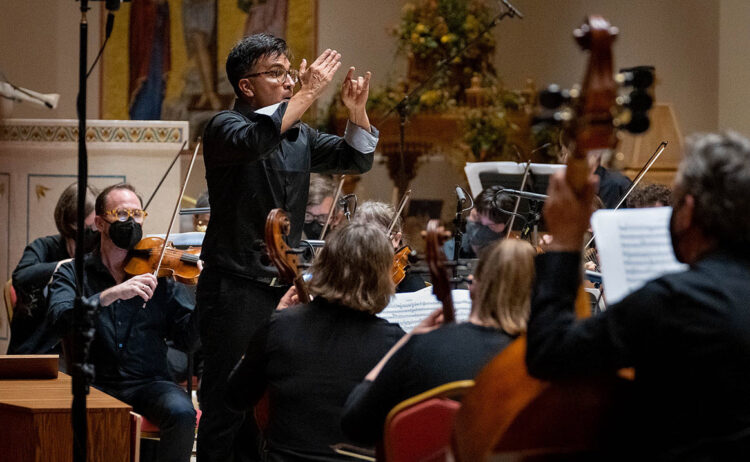
Like every ensemble in the spring of 2020, Bach Collegium San Diego, the city’s only professional period-instrument orchestra and chorus, was suddenly unable to give concerts. Collegium board president Gary Payne described the initial pivot: “The weird flip-side to the pandemic, especially for nonprofits, is that we had a little more money to play with,” and Payne, a professional photographer, helped the ensemble make concert videos. The habit of posting YouTube videos stuck. Bach Collegium San Diego (BCSD) founder and music director Ruben Valenzuela agrees that over the last few years social media “has been quite powerful in spreading word of the fun in what we do.”
By adapting to COVID pandemic restrictions, and with innovative multicultural initiatives, they have earned critical praise, enticed new audiences, and won accolades — including EMA’s 2023 Laurette Goldberg Award for outstanding community engagement.
Valenzuela created BCSD in 2003, performing mostly popular repertoire, what one singer described as “from small-scale secular French cantata to full-orchestra Bach oratorio,” with Monteverdi, Handel, and Purcell in the mix. It wasn’t until 2021 that they grew large enough to hire their first full-time executive director, Katie Hickey, who’s charged with raising funds and writing grants as well as producing the ensemble’s recordings for online concerts. On many levels, she says, “They brought me on to help navigate the pandemic.”
Meanwhile, BCSD was working on something that would grow to huge cultural significance: the El Mesías project, a translation of Handel’s Messiah into Spanish.
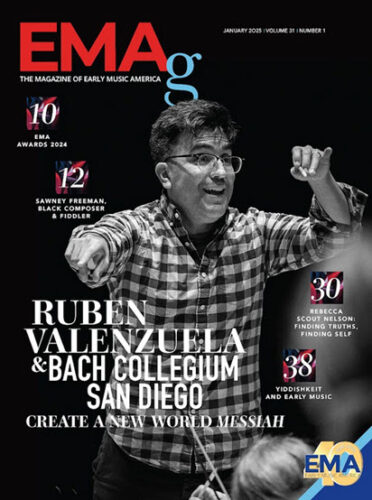
“That has become our key bit of outreach,” says Valenzuela, who often hears from groups curious about performing the refashioned oratorio. El Mesías is very personal to Valenzuela. “I grew up in a Spanish-speaking church, and they would perform Messiah, portions of it, every year. I walked away at that time with the assumption that this piece had been created originally in Spanish.”
The board had long encouraged annual performances of Messiah as a money-maker but, artistically, Valenzuela didn’t like exact repetition. He dug up the various configurations that Handel wrote to accommodate personnel available. “We came to a point where we had exhausted most of the viable versions.” That’s when he considered performing a Spanish translation, reasoning that the composer himself, and nearly three centuries of interpreters, gives the work “this long history of being shaped and manipulated in ways that adapt to its context and its environment. It felt like the right thing to do.”
However, they couldn’t find a complete Spanish version. So in 2021, Valenzuela convinced the board to commission a new translation — the conductor has an amazing “ability to bring people along,” recalls long-time board member Lee Talner — and they connected with Mario Montenegro, a choral conductor just south of the border, in Tijuana, who had recently done a translation of La bohème into Spanish.
Montenegro jumped at the opportunity: “It’s a universal work of art. I felt that doing this, having this work in Spanish, would be an addition to the universal value that Messiah has.”
The two men agreed on their approach. “We were not interested in a literal translation,” recalls Valenzuela, “but something that was singable and also conveyed the spirit of Charles Jennens’ English-language libretto.” They worked online, with Montenegro sending sections as he wrote them, and Valenzuela playing and singing through them as they arrived.
Messiah for a New World
The main challenge was “to have the music fit into the language,” says Montenegro. “Spanish and English are very different in their structure, and most important, the musicality of the languages are very different.” He focused on the underlying intent of the English, trying “to keep the spiritual meaning and also to find some beauty in the words.”
Montenegro describes a particularly tricky passage: “All we like sheep are gone astray.”
“All those words in Spanish would be too much to be concentrated in that sentence,” the translator says. “So instead of expressing the destruction that they may have in order to come into spirituality with God, I decided to do it in the opposite way, like a celebration of that spirituality. It was not ‘gone astray,’ it was a celebration. It could be a little bit controversial, but I think we got to the same point.”
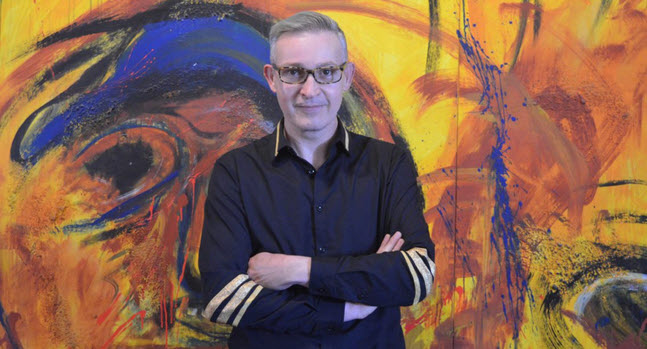
Decisions like this followed a basic principle: “The music is already written. You want Messiah by Handel, not Messiah by anybody else.” Adding to the challenge, the composer had initially created some of the aria tunes to set Italian lyrics, later reusing those melodies for Jennens’ new text; the result was word settings that are awkward in the familiar English version. (To take one famous example: The music of “For unto us a child is born” was originally set, more idiomatically, for Handel’s cantata “No, di voi non vo’fidarmi.”)
Putting it all together also proved difficult. “The most complicated part was the technical process,” says Montenegro, who collaborated with a fellow musician in Tijuana to create the score in music software.
But even when a premiere date was set for March 2022 in San Diego, the work wasn’t done. “In the week leading up to the first performance, we really workshopped it,” says Valenzuela. “The singers sent in their recommendations for text underlay and things that didn’t work so well. Some of those were altered in real time in rehearsals, and then we made them happen in the performance.” When they performed it again in 2023, “there were some new singers, new eyes, and we found that we needed to do some adjustments again.”
The score of El Mesías is now published with GIA Publications, with the subtitle Handel’s Messiah for a New World.
Although Valenzuela used some of his Spanish-speaking core singers for the first performance, he avoided hiring singers based only on their native tongue. “That defeats the purpose. We don’t do that while we’re doing something in German or Italian.” He ended up with six soloists, three of whom spoke Spanish. One was Cecilia Duarte, a Houston-based mezzo-soprano. “When she arrived, I was really shocked to find out that she had never sung Messiah. But she was probably the most fluent of all in the language.”
The project had deep meaning for Duarte. “I am from Mexico, from a Catholic family. We listened to the Messiah growing up, but also we heard it in church. Many of those words came back to me, like when I went to catechism or when my mom was talking to me about the Bible.” She was impressed with the translation. “The work that Mario did just read very naturally. Also a helpful element is how clear Spanish vowels are, none of the diphthongs like ‘refiners fire.’”
Rehearsal was a collaborative effort. Duarte made suggestions to improve the text underlay and pronunciation, while she in turn was helped by “English speakers that have done this work for so long, that know where the right places are for accentuation or how the articulation of the phrase should go.”
Tenor Jacob Perry was hired to join the 2023 concerts after singing some Latin American polyphony with the Washington Bach Consort, guest-conducted by Valenzuela. “It’s interesting to take a work that you understand fundamentally in your native tongue and then figure out how to turn the experience of that into a different language,” Perry says. He found it a challenge to puzzle out “how do I keep intact what Handel put in, in terms of the melodic stress and where the harmony is moving?”
For example, the phrase “thou shalt break them,” with its quick, crisp consonants, is quite different in the translation, Perry says. “The Spanish ‘destrozados’ is one word, which has this really beautiful, sinister color to it, and you’re also making a larger shape over that while trying to get that marcato gesture underneath it.”
El Mesías’ 2022 world premiere was in San Diego. “We thought and hoped that we would get a big amount of the Spanish-speaking population here in San Diego to show up,” says Payne. But that didn’t happen. “Frankly it was partly that we just didn’t know how to market it to that community.” Some of their usual audience was hesitant. “We had some feedback like ‘I’ll go when you do it in English again.’”
Valenzuela is grateful for the many San Diego-based supporters who enthusiastically support El Mesías. In 2023, a critic for San Diego Story wrote that he “was unprepared for overwhelming emotional impact this year’s performance made” although he’d also heard it in 2022. Not everyone was on board, however, Valenzuela admits. “I even got some feedback from folks asking me ‘Is your intent only to perform it in Spanish? Because to me Messiah is something that I hear in English.’ By no means are we out to perform it solely in Spanish!”
When Montenegro attended the San Diego premiere, he had never heard his libretto sung live. Pandemic border restrictions had kept him from crossing over for rehearsals. “The first word from the tenor when he began to sing, I knew that it was real, all that concentration and work thinking about the words, thinking about the spiritual meaning of the libretto. I was very happy and honored and humbled.”
‘The people there were so appreciative that we were bringing something so culturally significant, this icon of a piece, in their language.’
He and Valenzuela describe El Mesías as a gift to those who otherwise might not have access to this masterwork. Thus, it seemed essential to also sing it across the border in Tijuana. Montenegro helped them arrange to perform at the CECUT, the city’s cultural center, in 2022. Because it’s a government-run facility, tickets were free. “The excitement was off the charts,” says Valenzuela. “The people there were so appreciative that we were bringing something so culturally significant, this icon of a piece, in their language.”
“They clapped after every single movement,” Duarte says. “For me as an immigrant, living here, sometimes we don’t know the level of the quality of the things we do because it’s quite standard. Just going out and breaking barriers and collaborating between communities, that’s just a great thing to see happening in the early-music industry.”
Hickey recalls the crowds of “over 600 people of all ages and walks of life. People bring their babies and kids there, and it’s just part of the culture.” As BCSD board chair Gary Payne puts it, “It was all the different things that you hope and pray for on any given concert date. It was the audience that you want to see.”
Tenor Jacob Perry sang with them when they returned to Tijuana in 2023. He notes that, when English-speakers hear Messiah, “they’re registering the things as you’re saying it, and there’s no supertitles or reading necessary. To do that in Spanish and have that visceral feeling of excitement understanding and profound movement in the vernacular felt like we were doing something really important.” He hopes to see “a whole wave of new translations into different local vernaculars, because I think that might be a strategy for early music’s continued relevance.” He clarified: “I’m not saying that we should stop singing Bach in German.”
From the Brewery to the Taco Stand
Bach in German (and similar repertoire) remains standard fare for BCSD’s four annual mainstage concerts in San Diego. They venture into somewhat less familiar territory in their lunchtime concert series, Bach at Noon. Those free programs have become another source of outreach since the pandemic. Their audience increased when they changed from their long-standing Wednesday schedule to Fridays.
The series allows BCSD to reach new listeners. Valenzuela estimates that a quarter of the noon audience does not attend the mainstage concerts. “The programs are shorter, and they’re quite varied, like a little taste-test of composers.” The other big recent change, besides moving to Fridays, has been to repeat some lunchtime programs in the evening, at non-traditional venues. “We’ve done everything from a brewery to a brewery-slash-taco venue in a very urban place.”

Hickey, BCSD’s executive director, remembers the brewery concert as “really fun, a little raucous, and standing-room only.” The repertoire must be “fast and loud, because there’s a din of noise always going on,” Valenzuela explains. A natural-born extrovert, theorbist John Lenti served as emcee at the brewery. “He was very much at home in this environment,” says Valenzuela. He’s noticed that people who happen to be at such venues are drawn to their music.
Lenti, who commutes to BCSD from Seattle for a couple of programs per year, has a reputation as part of the company’s spectacle. “I show up with the weird-looking instrument,” he says. Inevitably, people ask about the theorbo, so he does a spiel. “It’s turned into a near requirement.”
This is true at the more “formal” concerts as well, says Hickey. “We tend to be interactive and a bit playful. We break that fourth wall, if you will, and we’ll talk to them. We treat them more like friends and family.”
She sees it as part of BCSD’s mission to make everyone feel welcome. “Our Bach at Noon evening performances allow working families to come hear our music in a less formal setting so they do not need to worry about kids disturbing anyone. But we also encourage families to come to all our concerts. We offer open rehearsals.”
What impresses Lenti most about the Bach at Noon concerts and their lively evening variants is that they are “absolutely separate from their mainstage series.” As a freelance musician who’s seen many an early-music ensemble founder, he thinks it’s essential that BCSD continues to focus on large-scale masterworks on their subscription concerts.
‘I’ve never managed successfully to lecture a group of children without also teaching them to dance the pavane.’
Another of Lenti’s contributions to BCSD culture was a session teaching kids about Baroque music. There’s an elementary school across from All Souls’ Episcopalian Church, where BCSD rehearses and often performs. “They brought over three classes of third and fourth graders.” Lenti adds, “I’ve never managed successfully to lecture a group of children without also teaching them to dance the pavane.”
Valenzuela would like to do more school outreach, but the venue is a problem. “It’s hard for us to convince the school that we have nothing to do with the church, so we’re not going to indoctrinate your students.” Despite that obstacle, BCSD has done a number of programs for kids.
What’s next? La Pasión según San Juan?
On May 25, 2025, they’ll premiere a youth-focused presentation that grew from another seed planted during lockdown, when countertenor Reginald Mobley collaborated with Valenzuela on a video called “Bach to Bop.” It showed similarities between Baroque and jazz music, “mainly through their basslines, ostinatos, ground basses, that sort of thing,” says Valenzuela. “We did music by Purcell, Bach, Handel, and then we would weave in and out of that into jazz stuff — Sarah Vaughan, Ella Fitzgerald,” all over continuo backing. Along with presenting “Bach to Bop” as a live program, they’re turning it into a package for schools. “If there’s a music teacher who wants to talk about this stuff, we will assemble the materials needed.”
BCSD also made its first recording during the pandemic, in 2021: a pairing of Handel’s Dixit Dominus and Bach’s Cantata No. 4, Christ lag in Todesbanden. It was never released. Recently the ensemble signed with the Brooklyn-based label Bright Shiny Things (BST); the recording was released in March 2025 with a title A Sonic Youth.
The next logical step is to record El Mesías. “If anybody does it, it should be us,” says Payne. “We need to hurry up and make the definitive recording,” agrees Hicky. “That’s what I’m currently fundraising for.” [Editor’s note: The recording was made in late 2025, to be released in 2026.]
In June 2024, the Collegium’s choir made its first trip to Europe, performing at the annual BachFest choral bonanza in Leipzig, plus two run-out concerts in Arnstadt and Naumburg. Hickey put together a package allowing their Southern California patrons to follow the mini-tour. Valenzuela envisions a tour “maybe every two to three seasons, where we tour El Mesías into Latin America. That’s a dream of mine.”
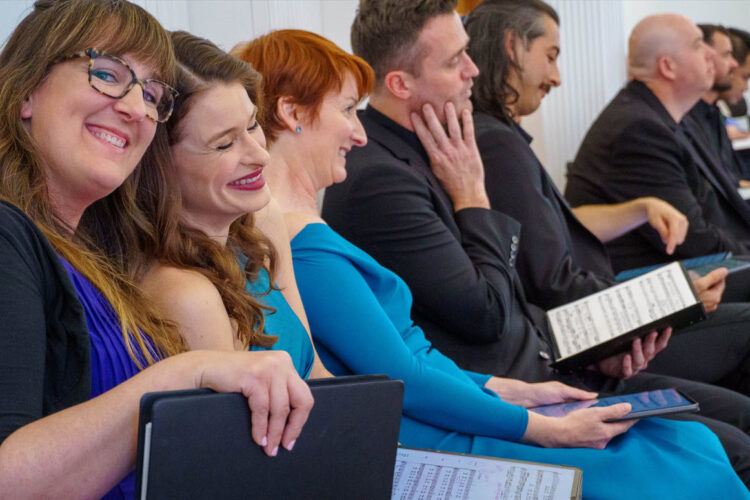
Asked whether another large-scale translation project is in the offing, Rubens replies, “Jokingly, folks have said, ‘What’s next, the St. John Passion?’ But I have zero interest.” Yet Montenegro hopes someday they can tackle a Baroque opera in a New World setting. Antonio Vivaldi and Carl Heinrich Graun, for example, each composed an opera called Montezuma, set in Mexico. (The preface to Graun’s score, with an Enlightenment-era libretto by Frederick the Great, summarizes the plot about the last Aztec king and the Spanish conquistadors that he believed were gods: “The lamented end of this good monarch, who was sacrificed to the cruelty and greed of his guests’ barbarous ways.”)
For his part, Valenzuela is more interested in commissioning new music for period instruments. He doesn’t want BCSD to “be pigeonholed as the ensemble that just does old music on old instruments, but to show that these are viable instruments in and of themselves.” Among the ensemble’s string players is composer Andrew McIntosh. “We’ve had some conversations, very casual, about the possibility of commissioning him to write something.” Valenzuela envisions a program of thematically connected new and old music.
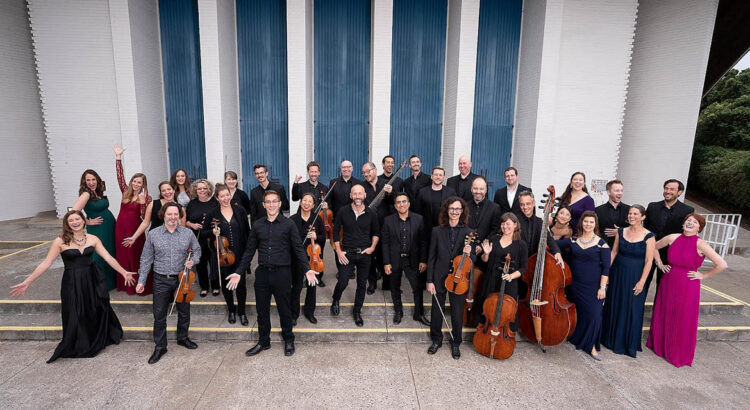
In light of these ambitious goals, it’s no surprise that board president Payne wishes for “financial stability” and Hickey would like to expand the staff. Still, BCSD is doing something right, says theorbist Lenti: “They haven’t got big-venue fever or the growth mindset that seems to be the death knell of so many Baroque groups.”
Tenor Perry credits the mutual trust he finds across the BCSD organization: “The sense of being on a ship together, and we are in the same boat and everyone is listening and reacting to each other.” It’s a mindset repeated on stage, Perry continues, “Ruben does a great job of not getting in the way of us being able to have that kind of musical interconnectivity.”
While BCSD works with an annual budget of under a half-million dollars, Payne believes their presence is felt. From El Mesías to its brewery-to-taco-stand shows, they can boast of connecting with new audiences and in new ways, while keeping their old fans happy.
“We’re creating a really high-quality music product. This particular niche of early music, nobody else is doing it in San Diego. At least we’re making a blip on the radar screen.”
Anne E. Johnson is the EMA Book Editor and a frequent contributor to EMA and Classical Voice North America. She teaches music theory, ear training, and composition geared toward Irish trad musicians at the Irish Arts Center in New York and on her website, IrishMusicTeacher.com. For EMA, she recently wrote about Searching for the ancestors and finding Eve in sound.

